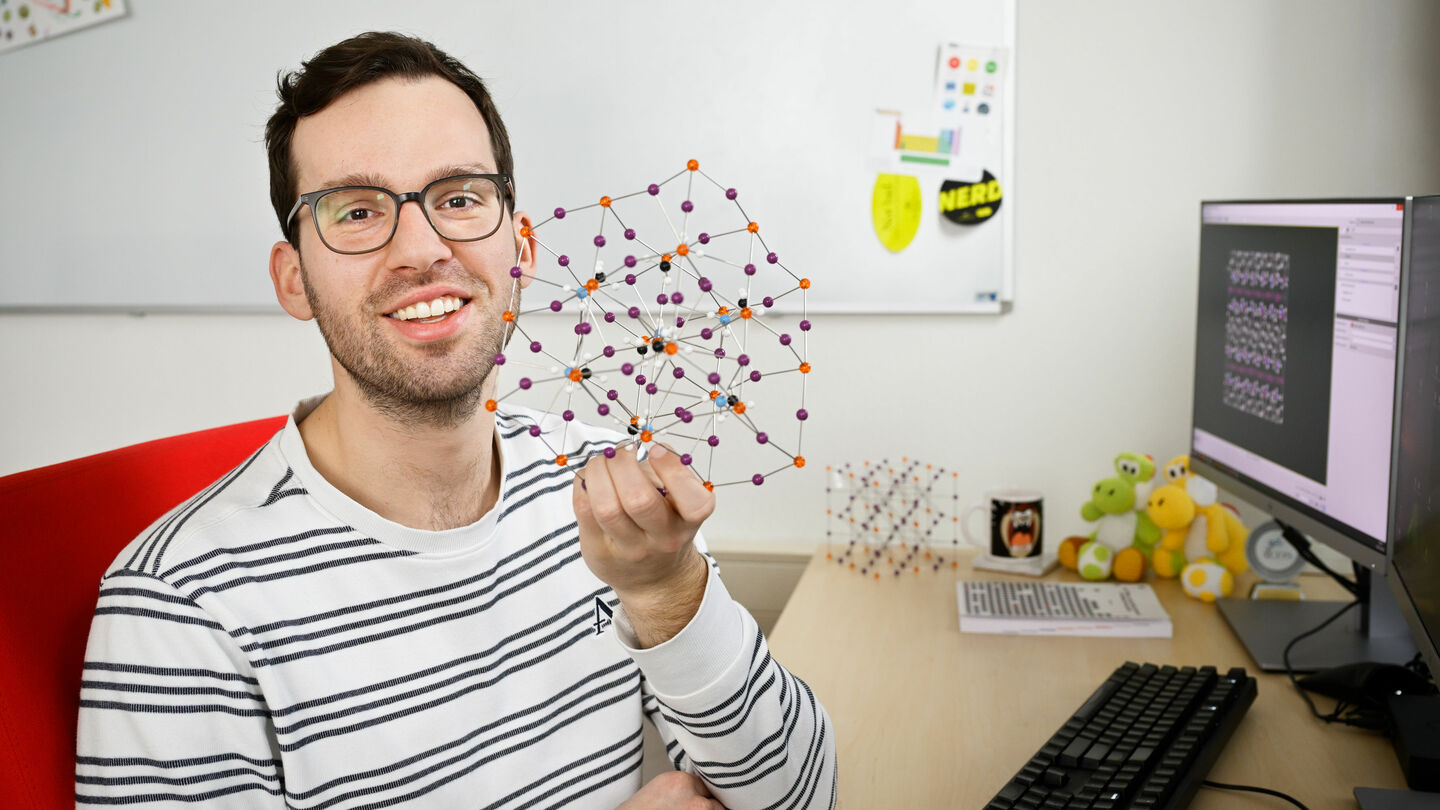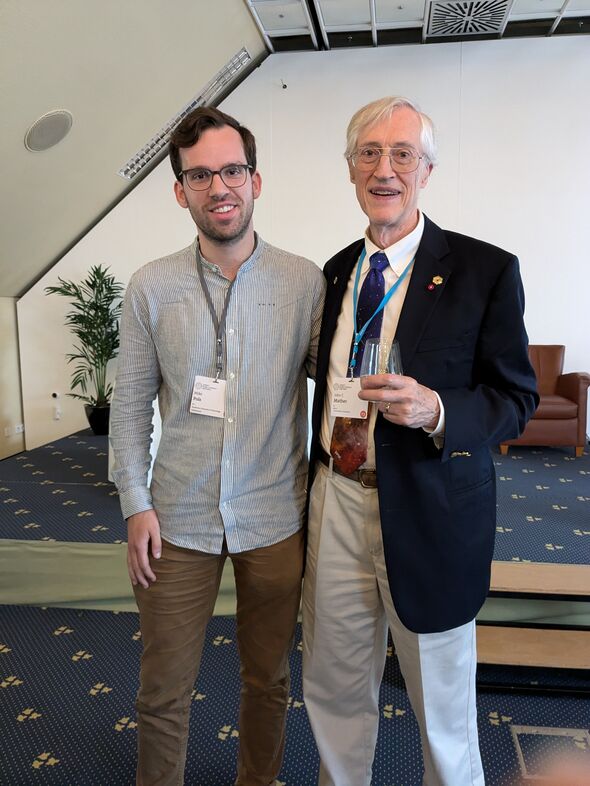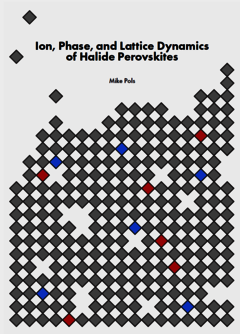
Home Stretch | Solar cell of the future
PhD student Mike Pols studied perovskites, a promising material for use in solar cells
Its unique crystal structure and special properties make perovskite a promising candidate for the solar cell of the future. But in order to fulfil this potential, there are still quite a few challenges to overcome. In his thesis, Mike Pols offers more insight into the processes within this material – knowledge that can help improve the stability of perovskites. Today he defends his dissertation at the Department of Applied Physics & Science Education.
Thanks to his double bachelor’s and master’s degrees, Pols has a background in both chemistry and physics – exactly the expertise needed for his research on materials for electronic applications, such as solar cells, LEDs, and photodetectors. “In our research group, we study what processes take place in the material, with the goal of improving it for different applications,” he explains. “Unlike some other groups, our work is exclusively based on simulations.”
The material he is concerned with is perovskite – a mineral that turns out to be particularly promising for use in solar cells. His work deals with a specific class of perovskites – halide perovskites – that have the potential to replace silicon and form the basis for a new generation of solar panels.
Unique, but unstable
“Perovskite is a mineral with unique properties,” he says. As halide perovskites absorb light very well, they’re particularly suitable for use in solar cells. Moreover, they are easier and cheaper to make than silicon solar cells, while offering almost the same efficiency. This makes them ideal for applications in which weight plays an important role, such as in solar panels for buildings or in vehicles.
But the material also has drawbacks, Pols admits. “The biggest disadvantage is that the material is very unstable and falls apart quickly,” he says. Current perovskites normally remain stable for no more than three months. “Imagine if I sell a solar panel like that to someone and it falls apart after three months. They won’t be happy, as you understand,” he says with a smile. “So one of the big challenges is: how do you get the material stable?”
Customize properties
Fortunately, the material is particularly modular, meaning that the chemical composition and crystal structure of perovskites can be modified relatively easily by adding or taking out different elements. “You can add atoms and achieve the desired structure, such as different layers on top of each other,” Pols explains. “That way you can tailor the properties of perovskites to specific applications.” In addition, it’s possible to create so-called chirality – an asymmetry in the chemical structure, which makes the material absorb light in a different way.
All these possibilities make perovskites extremely versatile. “In theory, we can solve the stability problem by modifying the structure,” Pols says. “But for that we first need to understand what happens exactly. Right now, we don’t really know why the material falls apart.”
Too much to keep track of
With his research, he seeks to provide more insight into these processes. And he’s certainly not the only one; perovskites are a particularly dynamic and active field of research. The cabinet in the hallway of the Cascade building, which houses his research group, is therefore full of dissertations with perovskites in the title. Researchers focus on a variety of aspects of the promising material. “Some concentrate on improving energy efficiency, while others do experimental research on material properties, such as the movement of atoms within the material,” he clarifies.
“An awful lot of papers are published on this subject every day, too many to keep track of. There are even entire conferences devoted to perovskites,” Pols says. The enormous flow of new knowledge is valuable, but sometimes you can’t see the forest for the trees, he admits. “As a researcher, you always have to make choices about what to delve into, and you can never get a complete overview of the entire field.”
Diagnosing
Pols’ work focuses on better understanding the process by which the material disintegrates. “Experiments show that the chemical structure changes with time, causing the material to lose its original functionality. It’s broken, so to speak,” he explains. This process is intrinsic and occurs naturally, similar to aging, but is accelerated by external factors such as exposure to oxygen and water.
“In the lab, we can see that the structure has changed, but not down to the atomic level,” he says. In his research, Pols investigated what exactly happens at the atomic scale. Where and under what conditions does the material fall apart? “It’s not a solution yet, but it’s similar to making a diagnosis. If you know what happens, you can investigate how to make the material more stable,” he says.
Simulations
To find out, he conducted simulations. “After creating a digital model of the material structure, you can introduce a small defect by removing an atom. And then you observe what happens,” he explains. “For example, we discovered that not all defects are bad or lead to instability. The next step was to determine which defects actually make the material unstable. If you can identify those bad defects, you can then investigate how to prevent their formation in the material.”
One problem with simulations is that the quality of the output depends on the quality of your model. In other words, to what extent it matches reality. To get accurate data, it’s important to have a good model. “Half my time was spent training a model with data to ensure it would be an accurate reflection of reality. The rest of the time I was using the model for simulations,” Pols says.
Virtual microscope
With these simulations, he showed exactly how the defects pass through the material and what effect they have on stability. “I actually created a kind of virtual microscope, which allows you to see exactly what is happening at the atomic level,” he summarizes. “This contributes to a deeper understanding of the material and what we observe during experiments.”
“Experiments are often ahead of simulations. We see many things but can’t fully understand them yet. My research is shedding more light on this,” he says. “Now the ball is back in the court of experiments. Other researchers can continue to work with these findings and see if they can demonstrate and measure them in the lab. If so, they can be translated to processes and eventually to concrete applications, such as solar cells.”
So will we soon have solar panels 2.0 based on perovskite solar cells? “That’s all up in the air for now,” Pols responds. “There are so many production facilities for the current solar cells and so many existing solar panels that the new solar cells really need to be much better to make it worth replacing the old ones,” he states. “We’re also looking at whether we can add layers of perovskites on top of the existing solar panels to make them more efficient. That would be a smaller intervention, but still have a beneficial effect.” Either way, thanks to his research, we now know more about the material, which brings us closer to its concrete application.
PhD in the Picture
What is that on the cover of your dissertation?
“It’s an artist’s rendering of the crystal lattice, a simplified version of the chemical structure of perovskites. You see holes in the structure – those are the defects – and the different colors of cubes indicate that you can add different kinds of atoms, almost like Lego bricks.”
You’re at a birthday party. How do you explain your research in one sentence?
“I use a virtual microscope to study how perovskites – a promising material for solar cells – move, fall apart, and get new functionalities.”
How do you blow off steam outside of your research?
“I am an avid water polo player. Playing sports is the ideal way for me to relax.”
What tip would you have liked to receive as a beginning PhD student?
“When you publish a paper, this doesn’t automatically result in confetti and pats on the back. Instead of waiting for outside recognition, pause to reflect on your milestones yourself and take the time to enjoy them.”
What is your next step?
“I’ll start working as a postdoc at another TU/e group, continuing with materials science, but with a focus on other materials and on vibrations within those materials.”



Discussion